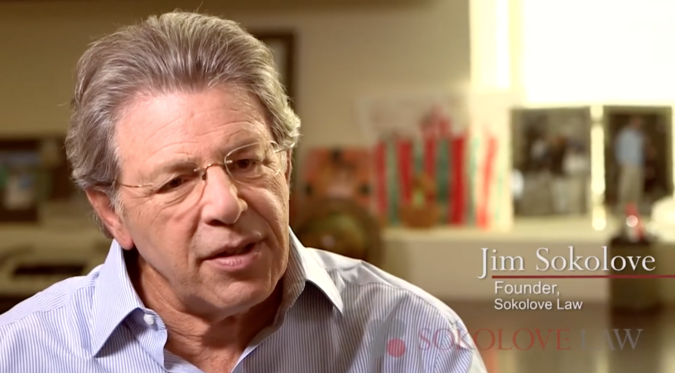Fighting for Mesothelioma Victims for Over 45 Years
For much of the 20th century, companies used asbestos in their products because it was cheap, durable, and resistant to heat. However, exposure to asbestos has been linked to cancers like mesothelioma for decades.
Many companies knew about the risks their products posed — but they hid this information from the public and prioritized profits over the safety of their workers. We can help families hold these companies accountable for the harm they’ve caused.
As a national mesothelioma law firm, Sokolove Law offers:
We understand the physical, emotional, and financial toll a mesothelioma diagnosis takes on patients and their families. Let our attorneys pursue the justice and compensation you deserve.
How Mesothelioma Lawyers Can Help
At Sokolove Law, our mesothelioma lawyers can travel to you for free and handle every step of the legal process on your behalf. This way, you can focus on your health and family during this challenging time.
Our mesothelioma lawyers can help clients in all 50 states:
- Identify the asbestos-containing products you were exposed to, since exposure occurs decades before a diagnosis
- Determine which companies made, sold, and distributed these products
- File claims against these companies to hold them accountable for causing your illness
- Negotiate settlements to get you compensation as quickly as possible
- Present your case in court if a settlement is unable to be reached
More than 99% of our mesothelioma cases result in settlements, which award $1 Million to $1.4 Million on average.
Our results have provided families across the country with financial security and peace of mind after a mesothelioma diagnosis. Get started now with a free case review.


“Hiring Sokolove Law was the smartest thing we ever did. Filing the lawsuit was easy because the firm made it easy. We didn’t have to do anything.”
– John, Mesothelioma Survivor & Firm Client
What Causes Mesothelioma?
Mesothelioma is an aggressive cancer caused almost exclusively by exposure to asbestos. When asbestos fibers are disturbed, they’re often released into the air.
If inhaled or ingested, these microscopic fibers can irritate healthy tissue within the body and cause mesothelioma to form 20 to 50 years after exposure.
Many mesothelioma victims have been exposed to asbestos:
- At work or on the job, including bystanders who worked near asbestos
- While serving in the military
- Secondhand, from asbestos fibers carried home on a loved one’s work uniform
- From asbestos-contaminated talc products like baby powder
If you don’t know how you were exposed to asbestos, our team is here to help. We’ll ask you a few questions about your life and work history to determine this for you.
Around 3,000 Americans are diagnosed with mesothelioma each year, which makes this cancer very rare.
Patients and their families may be eligible for compensation from a mesothelioma lawsuit that can help pay for medical bills, lost wages, funeral costs, and more.
What is mesothelioma? Mesothelioma is a cancer of the lungs that is primarily caused by exposure to asbestos. That’s the basic thing that people have to understand. It is a cancer to the lining of the lungs that is 99% of the time caused by exposure to asbestos.
Who gets mesothelioma? We’re talking about people who worked in factories, worked around brake linings, worked in the military and found themselves in an unfortunate situation where the manufacturers of asbestos put profits ahead of people, did not inform these workers of the dangers.
People went to work, doing the right thing, and wound up catching an environmental disease that came about by the exposure to asbestos, when the manufacturers knew about this and refused to inform the workers.
Who’s at Risk of Mesothelioma?
Because asbestos was used in thousands of everyday products, from construction materials to car parts, many workers and U.S. military veterans were unknowingly exposed to asbestos on the job.
Since asbestos was widely used by the military, around 33% of all mesothelioma diagnoses involve a U.S. veteran.
Jobs with a higher risk of asbestos exposure include:
- Auto or aircraft mechanics
- Boilermakers
- Carpenters
- Construction workers
- Drywall installers
- Electricians
- Factory workers
- Insulators
- Miners
- Painters
- Plumbers
- Shipbuilders
- U.S. military veterans, especially those who served in the U.S. Navy
Virtually every naval ship contained asbestos, which put U.S. Navy veterans at an even higher risk of asbestos exposure and mesothelioma than other military branches.
Sadly, anyone who worked with or around asbestos could’ve carried the toxic mineral home with them on their clothing, potentially putting their loved ones at risk of mesothelioma.


“The reason why we're able to bring claims against the manufacturers who used asbestos in their products is because they knew it was dangerous. It's not your fault, and it should never have happened to you.”
– Ricky LeBlanc, Managing Attorney at Sokolove Law
If you’re unsure where or how you were exposed to asbestos, we can use our databases of evidence and decades of experience to help you figure it out.
Find Out How You Were Exposed
We've helped thousands of patients determine how they were exposed to asbestos. Let us figure out what happened and work to get you answers.
Types of Mesothelioma Cancer
Together, pleural mesothelioma and peritoneal mesothelioma account for the overwhelming majority of mesothelioma cases.
Pericardial mesothelioma and testicular mesothelioma are far less common, but no less devastating for patients and their families.
If you’ve been diagnosed with any type of mesothelioma, call our team now at (800) 647-3434 for a free case review. You may qualify for compensation that can help with the cost of treatment.
Pleural Mesothelioma
Malignant pleural mesothelioma occurs in the lining of the lungs (pleura). It is the most common type of mesothelioma, accounting for roughly 80% of all cases.
Common symptoms of pleural mesothelioma include:
- Chest pain
- Chronic cough
- Shortness of breath
- Tightness in chest
Pleural mesothelioma is categorized into stages that describe how far a patient’s cancer has progressed. Unfortunately, it’s often caught in the later stages, which makes it harder to treat.
The median life expectancy for pleural mesothelioma is around 18 months with treatment, depending on the stage and overall health of the patient at the time of their diagnosis.
Peritoneal Mesothelioma
Peritoneal mesothelioma forms in the lining of the abdomen (peritoneum) and makes up 10-20% of all mesothelioma cases.
Symptoms of peritoneal mesothelioma often include:
- Abdominal distension (swelling)
- Pain in the abdomen
- Vomiting and nausea
- Weight loss
The median life expectancy for peritoneal mesothelioma patients is around 50 to 60 months with treatment.
Pericardial Mesothelioma
Pericardial mesothelioma develops in the lining of the heart (pericardium). It is one of the least common forms of mesothelioma, accounting for around 0.7% of all cases.
Pericardial mesothelioma symptoms include:
- Heart palpitations (arrhythmia)
- Heart murmurs
- Irregular heartbeat
The average life expectancy of pericardial mesothelioma patients is approximately 6 to 10 months.
Testicular Mesothelioma
Testicular mesothelioma occurs within the lining of the testes (tunica vaginalis). It is one of the rarest forms of mesothelioma, accounting for less than 1% of all cases.
Testicular mesothelioma symptoms include:
- Inflammation or thickening of the testicular lining
- Swelling of the testicles
Patients with testicular mesothelioma have a median life expectancy of 24 months.
Mesothelioma Cell Types
Each mesothelioma cell type grows and spreads at a different rate, which can affect a patient's prognosis and treatment options.
Mesothelioma tumors are made up of three main cell types:
- Epithelioid mesothelioma: Associated with slow tumor growth, epithelioid mesothelioma makes up 70% of cases and responds well to treatments, giving patients a longer life expectancy.
- Sarcomatoid mesothelioma: Considered more aggressive, sarcomatoid mesothelioma often leads to rapid tumor growth. It responds poorly to treatments and makes up 7-15% of cases.
- Biphasic mesothelioma: A combination of epithelioid and sarcomatoid cells, biphasic mesothelioma is present in 10-20% of cases and its life expectancy falls between the other two types.
Once doctors identify a patient’s mesothelioma cell type, they can develop a personalized treatment plan that may help the patient live longer.
How Is Mesothelioma Diagnosed?
Diagnosing mesothelioma often involves a few steps to confirm the presence of this cancer, determine its specific cell type, and identify its stage.
To diagnose mesothelioma, doctors will:
Sokolove Law has registered nurses on staff who can help you understand your mesothelioma diagnosis and treatment options.
A cancer diagnosis is devastating — paying for travel to specialists, treatments, and other expenses shouldn’t add to your worries.
Get a free case review now to see if you may qualify for compensation from a mesothelioma claim.
The Risk of Mesothelioma Misdiagnosis
Many individuals may not realize they’ve been exposed to asbestos, which is a key factor in identifying mesothelioma. Mesothelioma symptoms often resemble other more common illnesses, making them harder for doctors to identify.
Over 20% of mesothelioma patients are misdiagnosed. When a diagnosis is delayed, it can allow the cancer to progress and limit a patient’s treatment options.
Pleural mesothelioma may be misdiagnosed as different respiratory conditions, like:
- A common cold
- Bronchitis
- Chronic obstructive pulmonary disease (COPD)
- Lung cancer
- Pneumonia
- Other asbestos-related diseases
Peritoneal mesothelioma, which forms in the abdomen, may be mistaken for ovarian cancer, Crohn’s disease, irritable bowel syndrome (IBS), or gallbladder issues.
"It's such a rare cancer that the majority of patients end up getting misdiagnosed or treated for a number of other things before it gets figured out."
– Dr. Joseph Friedberg, Mesothelioma Specialist & Surgeon
If you begin experiencing symptoms of mesothelioma, it’s crucial to inform your doctor about any history of asbestos exposure and seek a second opinion from an experienced mesothelioma specialist.
Mesothelioma Prognosis & Life Expectancy
A mesothelioma prognosis, which is the expected progression of the cancer, gives patients a general idea of what to expect after diagnosis and treatment.
Since mesothelioma is often diagnosed after the cancer has spread, the majority of patients have a poor prognosis.
Factors that can affect a mesothelioma prognosis include the:
- Age, gender, and overall health of the patient
- Location of cancer in the body (pleural, peritoneal, pericardial, or testicular)
- Mesothelioma cell type (epithelial, sarcomatoid, or biphasic)
- Mesothelioma stage (how far it has progressed)
- Treatment options (e.g., chemotherapy, surgery)
The average life expectancy for a mesothelioma patient is 22.5 months, while the average survival rate after one year is 82%.
A mesothelioma prognosis isn’t final. Some patients have lived for decades after a diagnosis, allowing them to spend precious time with loved ones and return to their favorite activities.
Can Mesothelioma Be Treated?
Mesothelioma treatments are available to some patients, especially in cases where the cancer is caught early.
Specialists can determine which options make the most sense for a patient and create individualized plans based on their health information, prognosis, and personal wishes.
The most common mesothelioma cancer treatments include:
- Surgery: Physically removing the mesothelioma tumors present
- Chemotherapy: Killing cancer cells using several rounds of drugs
- Immunotherapy: Activating the patient’s immune system to attack and kill cancer cells or slow their spread
- Radiation: Exposing patients to powerful rays of energy that damage the DNA of mesothelioma cells, shrinking them or preventing them from multiplying
- Clinical Trials: Conducting mesothelioma research to determine if new, cutting-edge therapies may help patients more than standard treatments
Doctors will often prescribe multiple types of treatments at once to increase their effectiveness, but this can lead to medical bills that cost upwards of $400,000 per year.


“Mesothelioma is an expensive disease to treat. A lawsuit certainly doesn’t take away what’s happening. But it allows you that flexibility, that you can take this money, and you can pay for any treatment that your insurance company may not cover.”
– Mary Hesdorffer, Former Director of the Meso Foundation
Our team can determine if you may be eligible for compensation to help pay for medical expenses and other costs related to your mesothelioma diagnosis.
Mesothelioma Financial Assistance
The high costs that come with mesothelioma treatments, in addition to any lost wages from being unable to work, may increase stress at a time when patients should be focusing on their health.
Fortunately, many mesothelioma legal options can provide patients and their family members with financial support.
At Sokolove Law, we’ve recovered over $5.1 Billion for thousands of families affected by mesothelioma nationwide.
Our team can pursue compensation from all of the options available to you in order to maximize your total payout.
However, you only have a limited amount of time to seek compensation due to legal deadlines, so be sure to contact us as soon as possible.


"I want people out there to realize that there is help, and they can get assistance and get a settlement from these manufacturers that continued to use asbestos while knowing it was dangerous for people."
– Dee, Wife of a Mesothelioma Patient & Firm Client
Around $30 Billion in Asbestos Trust Funds
There’s an estimated $30 Billion still available for mesothelioma patients and their families in asbestos trust funds.
Some asbestos-related companies tried to avoid paying the people who were exposed to their products by declaring bankruptcy, but courts ordered these companies to set aside money for current and future victims.
We can determine which asbestos trusts you qualify for and file claims with each one, so you can get compensation without leaving the comfort of your own home.
Over $1 Million Average Mesothelioma Settlement
Families affected by mesothelioma may be eligible to file a lawsuit against the companies responsible for their illness. The vast majority of these lawsuits settle out of court and award $1 Million to $1.4 Million on average.
Some of our past mesothelioma settlements and verdicts include:
- $40 Million for a U.S. Navy veteran with mesothelioma
- $11.49 Million to a demolition worker in Florida
- $10.5 Million for a pipefitter
- $4 Million to the family of a boiler worker in California
- $3.4 Million for a Colorado laborer and U.S. Army veteran
- $9.3 Million to the family of a U.S. Navy veteran in Massachusetts
- $11.12 Million for an Arizona mesothelioma patient
While there's never a guarantee of results, many of our clients start receiving compensation within 90 days of first contacting us.
Call (800) 647-3434 now. We’ll fight hard to get you everything you’re entitled to.
$3,800 or More in Monthly VA Benefits
Veterans with mesothelioma may qualify for disability compensation worth over $3,800 a month and free health care through the U.S. Department of Veterans Affairs (VA).
The VA typically awards mesothelioma a 100% disability rating. Our firm has VA-accredited attorneys on staff who can help veterans file VA claims or increase their current disability rating.


“It was only two or three days and my lawyer was here. It was a hands-on approach, and that's what drew me, ‘cause that's the way I do things...They were prepared. They could go back to day one, and I appreciated that.”
– Walter, Mesothelioma Warrior & Firm Client
We don’t file legal claims against the U.S. military or government, and taking legal action will not impact any current or future VA benefits.
Have You or a Loved One Been Diagnosed with Mesothelioma?
If you or a loved one has been diagnosed with mesothelioma, you may be eligible for compensation that can help pay for medical care and secure your family’s financial future.
At Sokolove Law, our mesothelioma attorneys recovered over $5.1 Billion for clients nationwide.


"My mission with the firm is simple: It’s to provide everyone, regardless of education, background, social status, equal access to the legal system."
– Jim Sokolove, Founder (Retired 2013)
We can pursue justice for families in all 50 states, and there are no hourly fees or out-of-pocket costs to work with our team.
Call (800) 647-3434 now or fill out our contact form for a free case review. Our team is ready to help 24/7.
Mesothelioma Asbestos Cancer FAQs
Can I get compensation for mesothelioma?
You may be eligible for mesothelioma compensation if you’re the:
- Patient diagnosed with mesothelioma
- Spouse, child, or family member of a patient who has already passed away
- Estate representative of a patient who has already passed away
The easiest way to tell if you or a family member may qualify for mesothelioma compensation is to get a free case review. We’ll gather some information and let you know more about your options.
While mesothelioma case values will vary according to a number of different details in each claim, the average settlement is over $1 Million.
What is malignant mesothelioma?
Malignant mesothelioma is an aggressive cancer that forms in the mesothelium, which is a protective lining covering the body's internal organs. The only known cause of this cancer is asbestos exposure.
There are four types of mesothelioma:
- Pleural mesothelioma, which forms in the lining of the lungs
- Peritoneal mesothelioma, which forms in the lining of the abdomen
- Pericardial mesothelioma, which forms in the lining of the heart
- Testicular mesothelioma, which forms in the lining of the testes
Contact Sokolove Law now if you or a loved one has been diagnosed with mesothelioma. We may be able to help you secure compensation for medical bills, lost wages, and more.
What is mesothelioma cancer caused by?
Mesothelioma cancer is caused by exposure to asbestos. This naturally occurring mineral was used in thousands of products during the 20th century.
Repeated and prolonged exposure to asbestos, like at a workplace where it’s used regularly, increases the risk of mesothelioma. Workers may also carry home asbestos fibers on their clothes, putting family members at risk of secondhand exposure.
When these microscopic fibers are inhaled or ingested, they can irritate healthy tissue in the body and cause cancer cells to form.
How much asbestos exposure causes mesothelioma?
There is no safe level of asbestos exposure. Even just a single asbestos fiber can have a devastating impact on your health decades later.
Extended exposure to asbestos may increase your risk of mesothelioma. Workers who were regularly exposed to asbestos at their jobs should notify their doctors immediately if they begin to experience mesothelioma symptoms.
What if you or a loved one is suffering from mesothelioma?
If you or a loved one is suffering from mesothelioma, you may be eligible for compensation from mesothelioma claims that can help pay for medical bills and other expenses.
Our attorneys can determine how you were exposed to asbestos and take legal action against the asbestos-related companies responsible for your illness.
However, there are deadlines, so be sure to contact an asbestos law firm as soon as possible after a diagnosis.
How common is mesothelioma?
Mesothelioma is considered rare. Each year, only around 3,000 Americans are diagnosed with this cancer. This means approximately 1 in every 111,000 people in the United States is affected annually.
What are the warning signs of mesothelioma?
Some warning signs and symptoms of mesothelioma include:
- Abdominal or chest pain
- Cough
- Fatigue
- Fever
- Loss of appetite
- Shortness of breath
- Weight loss
Because these symptoms are similar to those of other illnesses, mesothelioma is often not diagnosed until it has progressed to an advanced stage.
If you begin to experience any of these symptoms and you have a history of asbestos exposure, talk to your doctor right away.
What type of cancer is mesothelioma?
Mesothelioma is a cancer of the mesothelium, which is a thin layer of protective tissue that covers internal organs like the lungs or abdomen.
Because pleural mesothelioma forms in the lining of the lung, it’s often confused as a type of lung cancer.
How do you get mesothelioma?
The vast majority of mesothelioma cases are caused by exposure to asbestos. This carcinogen could be found in products throughout the United States for much of the 20th century.
If you inhale or ingest microscopic asbestos fibers, they may remain in your body for decades and eventually cause you to develop cancer.
Call (800) 647-3434 now if you or a loved one has been diagnosed with mesothelioma. Let us fight for justice and compensation on your behalf.
Is mesothelioma contagious?
No, mesothelioma is not contagious. While some cancers can be hereditary (passed down from one generation to the next), like breast and ovarian cancer, mesothelioma is not hereditary.
If multiple members of a certain family develop mesothelioma, it is likely that this is due to secondhand exposure to asbestos.
Secondary exposure can occur when a family member unknowingly brings home microscopic asbestos fibers that are attached to their clothes, body, or hair, after working around asbestos.
How do I know if I have mesothelioma?
The only way to know for sure if you have mesothelioma is to get a biopsy.
After listening to your symptoms and ruling out other conditions, your doctor can take a tissue sample and examine it under a microscope to confirm the presence of mesothelioma cells.
How long does mesothelioma take to develop?
Mesothelioma develops 20-50 years after the initial exposure to asbestos. This leaves many mesothelioma patients and their families searching for answers as to how, when, and where they were exposed.
At Sokolove Law, we have a warehouse of resources that can help us identify the asbestos-containing products you were exposed to — and which companies may be to blame.
Let us try to find out what happened and work to get you answers. Call (800) 647-3434 now.
Can smoking cause mesothelioma?
Mesothelioma is not caused by smoking. However, smoking can significantly increase the risk of mesothelioma.
Cigarette smokers are at least 50% more likely to develop mesothelioma after exposure to asbestos, according to studies.
Even if you smoked regularly and were later diagnosed with mesothelioma or another asbestos-related disease, you may still be eligible for compensation. Get a free case review now to find out.
Is mesothelioma always fatal?
Mesothelioma is not always fatal. While many mesothelioma patients are given a short life expectancy, long-term survival is possible, especially when this cancer is detected early.
Mary Jane, who was diagnosed with peritoneal mesothelioma in 2003, survived for 15 years before passing away from Alzheimer's disease.
Contact us now to see if we can connect you with top mesothelioma specialists and clinical trials exploring emerging treatment options.
How long can you live with mesothelioma?
It depends. Some patients may live for just a few months after their diagnosis, while others have gone on to survive for decades.
Factors that may affect how long someone with mesothelioma lives include:
- The type of mesothelioma they have
- Their age and health at the time of diagnosis
- Treatment options available in their case
Call (800) 647-3434 now to see if we may be able to fight for compensation that can help you afford mesothelioma treatments. It costs nothing to speak with us.
Can you survive mesothelioma?
Possibly. While mesothelioma is an aggressive cancer, others have been in your shoes — and are still around to tell their tales.
Hear the stories of mesothelioma survivors, some of whom have lived with this cancer for nearly 20 years. Their experiences provide hope and serve as a reminder that long-term survival is possible after a mesothelioma diagnosis.
Is mesothelioma curable?
Although there’s no cure for mesothelioma at this time, doctors are continually exploring new treatment options in search of a potential cure.
Advances in research and clinical trials offer hope for improved outcomes and better quality of life for patients in the future.
In some cases, mesothelioma can become stable. This means the progression of the disease may slow down or stop altogether, allowing patients to manage symptoms more effectively and prolong their survival.
Can mesothelioma be cured if caught early?
While there is no cure for mesothelioma, there are emerging treatments and clinical trials that show promise in helping patients beat the odds and have a better quality of life.
Catching mesothelioma early can improve a patient’s life expectancy, as more treatment options may be available because the cancer has not yet spread to other parts of the body.
There’s still hope for patients diagnosed with late-stage mesothelioma. John Stahl, a client who discovered he had stage 4 pleural mesothelioma in 2019, continues to fight against this cancer today.
How does mesothelioma kill you?
Mesothelioma is a terminal cancer. As the disease progresses, cancer cells begin to spread throughout the body. This is known as metastasis.
Eventually, these cancer cells may form tumors that overwhelm vital organs. As organ function deteriorates, the body's systems begin to fail, leading to multiple organ failure, severe debilitation, and, ultimately, death.
Find out more about end-stage mesothelioma and what to expect after a diagnosis.





